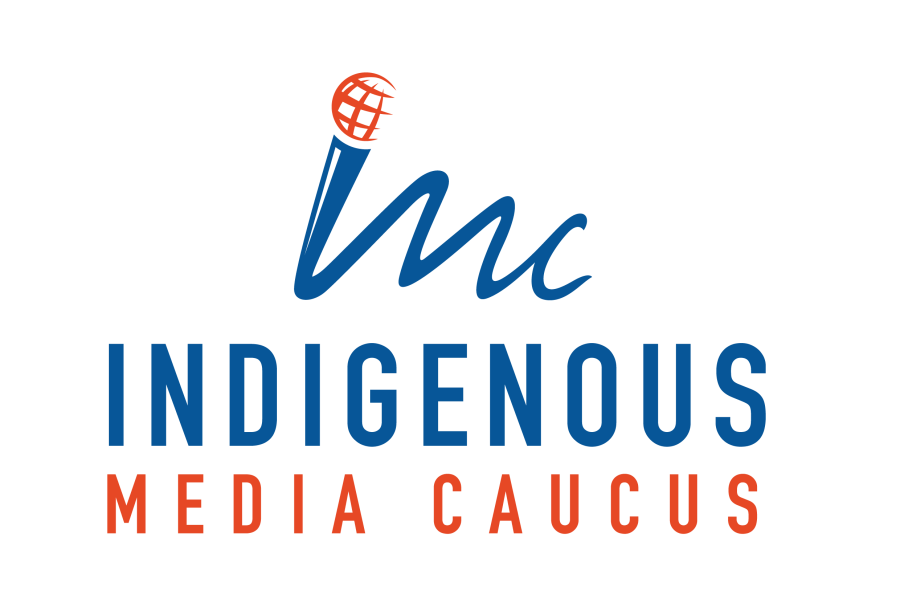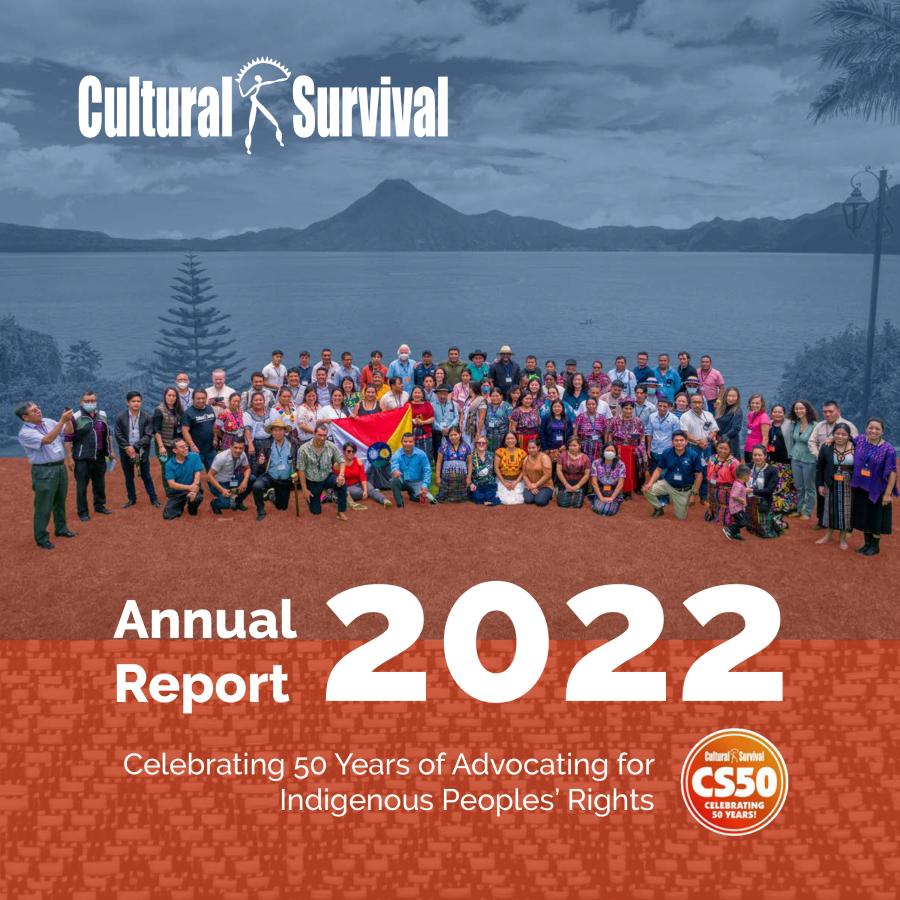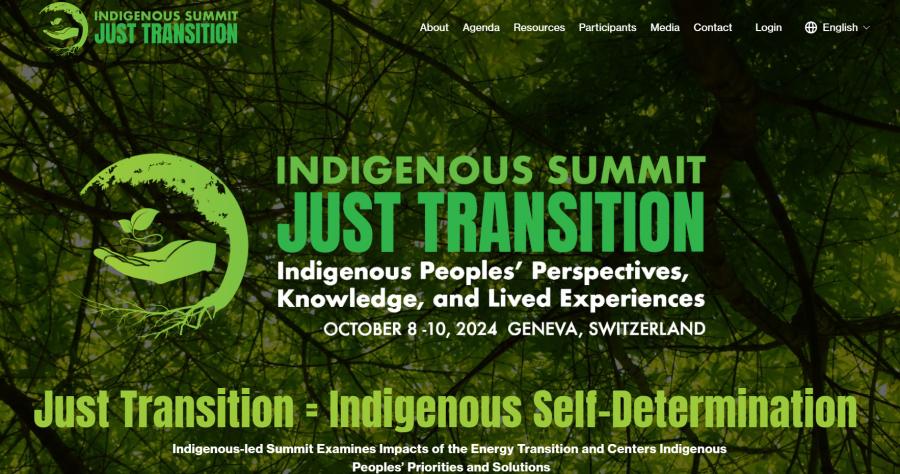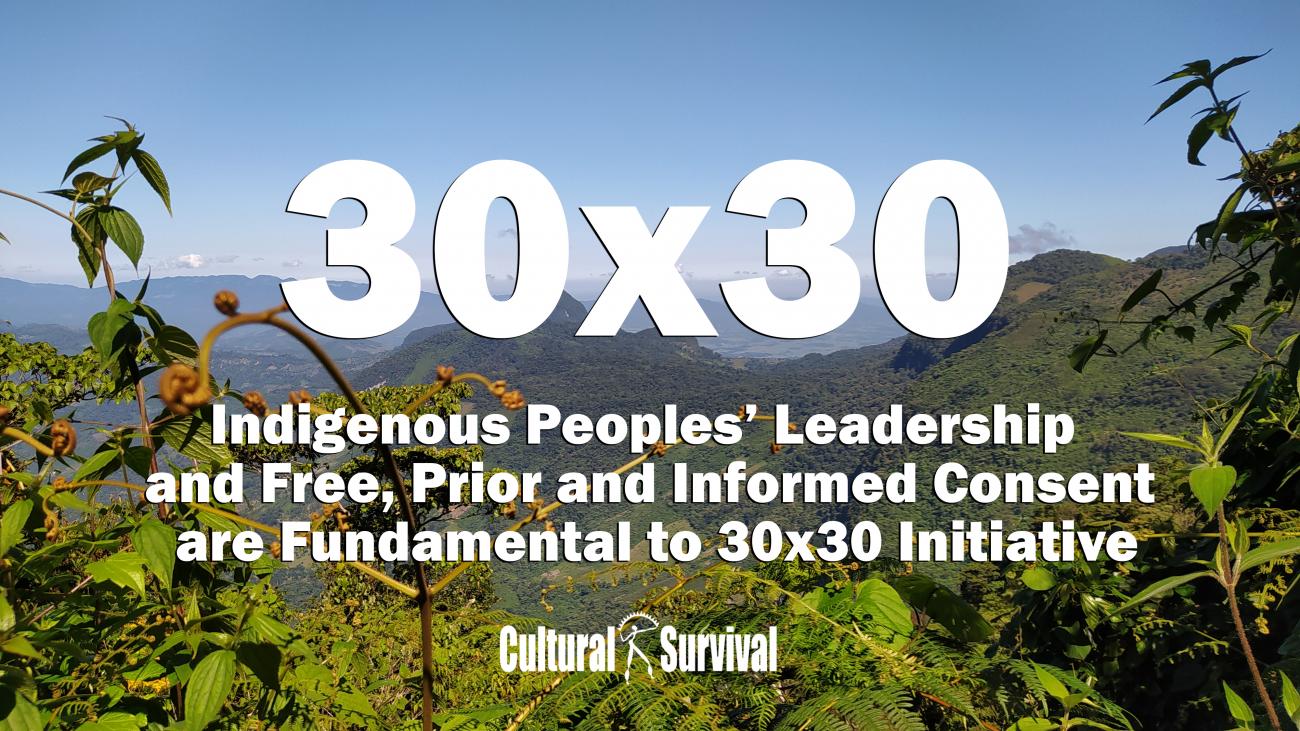
On January 27, 2021, U.S. President Joe Biden issued an executive order, “Tackling the Climate Crisis at Home and Abroad,” in which he called upon the Secretary of the Interior and other agency leaders to produce a report with recommendations on “[achieving] the goal of conserving at least 30 percent of our lands and waters by 2030.” With this step, President Biden added the United States to a group of over 50 countries that have joined the High Ambition Coalition for People and Nature and committed to at least 30 percent conservation by 2030, as stipulated in the Convention on Biological Diversity Post-2020 Global Biodiversity framework. Substantial recent scientific research supports this goal as foundational to addressing the global biodiversity and climate crises.
In response, the administration released the “Conserving and Restoring America the Beautiful” preliminary report on May 6, 2021. As an Indigenous-led organization that advocates for Indigenous Peoples' rights and supports Indigenous communities’ self-determination, cultures, and political resilience, Cultural Survival cautiously commends Secretary of the Interior Deb Haaland (Laguna Pueblo) and the Biden-Harris administration more broadly for the commitments the report makes to supporting Indigenous-led, community-based solutions. The U.S. has an opportunity to change course and to lead in this powerful international effort to protect the world’s ecosystems, mitigate climate change, and, in particular, to model Nation-to-Nation, consent-based collaborations with Indigenous Peoples on these issues of utmost importance to all life in the natural world.
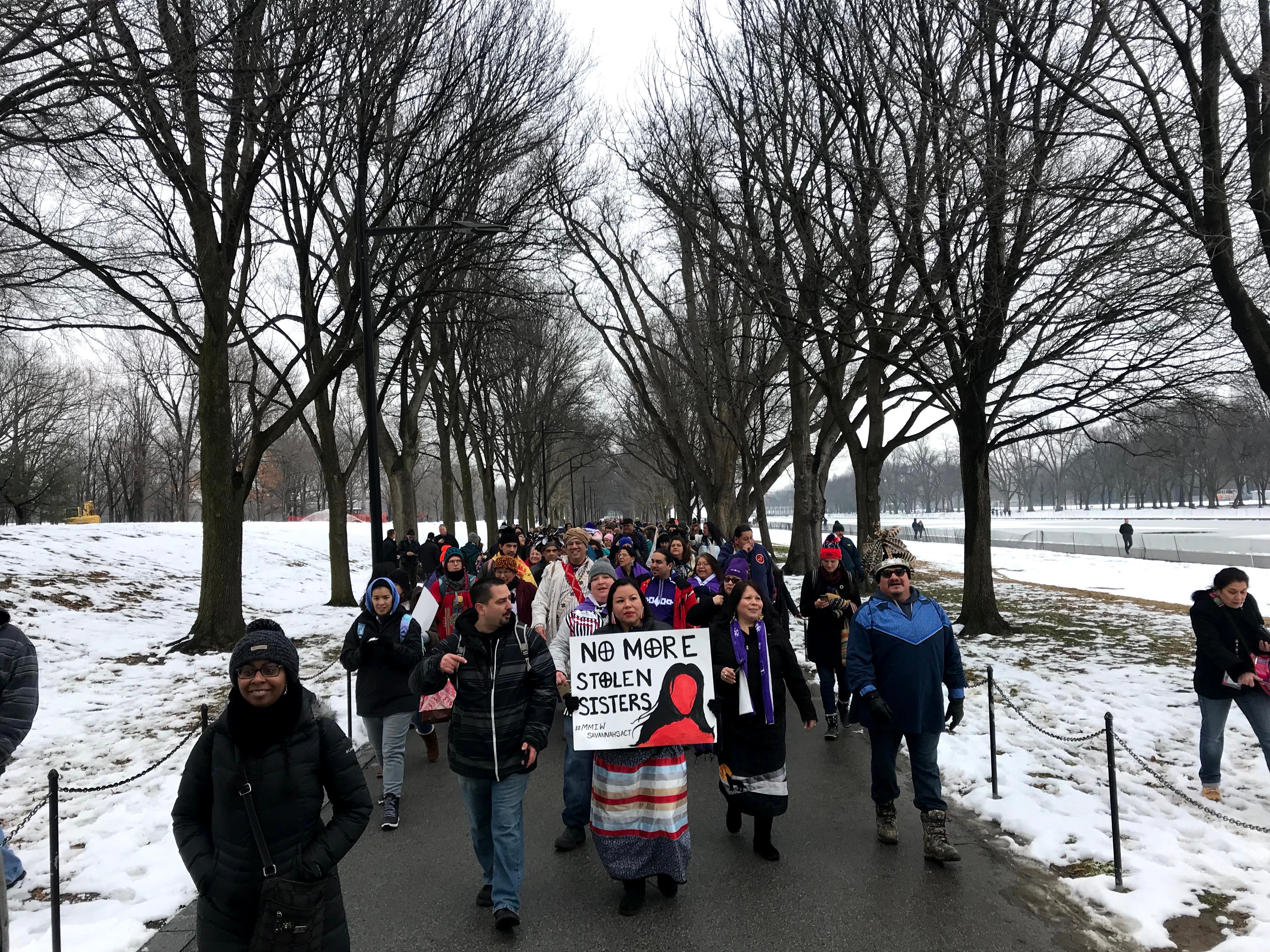
Indigenous Peoples March in Washington DC, January 2019. Photo by Daisee Francour.
Indigenous Leaders Address 30x30
First, we wish to uplift the perspectives and concerns of Indigenous communities and leaders with respect to the initiative. A Tribal Leader Statement on 30x30 Policy was signed by leaders of 25 Tribal Nations and organizations, emphasizing and elaborating upon the priorities of sovereignty, consultation, representation, resources, and evaluation in the implementation of the plan, and we encourage thorough incorporation of this comprehensive set of priorities. The Native American Fish and Wildlife Society is also consulting on the initiative.
On May 26, 2021, Native People’s Action, an Indigenous-led organization supporting Alaska Native communities, hosted a webinar with Indigenous leaders on the initiative. President of the Central Council of the Tlingit and Haida Indian Tribes of Alaska Richard (Chalyee Éesh) Peterson (Tlingit) said that the 30x30 executive order could be “part of the answer we have been looking for. Tribes and Indigenous knowledge will be key to the success of this initiative...This is an opportunity for the federal government to engage in real, meaningful government to government consultation and to honor our sovereignty over our traditional lands and our resources...I think as a Tribe, it’s been really exciting under the Biden administration that President Biden has really expanded consultation and expanded the definition so that departments are really held to a higher standard of what consultation is...so we have, I think, even more opportunity now to do government to government consultation...We’ve been actually inundated with requests from different departments to engage in consultation.”
Austin Ahmasuk (Inupiaq) spoke about his work with Kawerak, Inc., an organization serving Indigenous communities in the Bering Straits Region. He said, “The first moment that we heard about 30x30, our leadership became involved in the discussion...We didn’t want to see a cookie-cutter 30x30 applied for Alaska because of the different things that are occurring here. For us, fishing and hunting are really important to preservation, are really important to counteract the impacts of climate change. So Kawerak’s been involved in a lot of the national discussions around 30x30.” He considers involvement important because “historically, our region was not treated very well, as were many other parts of Alaska...Nome didn’t treat Native People very well.” He also elaborated on “really, really powerful economic, military national interests” who have set their sights on the Arctic for projects such as “increased shipping, deep draft port development, militarization, and large scale commercial fishing.” He said, “We in the Arctic, we want peace...Climate change policies must come with peace policies. We can't have peace if our countries are talking about militarization of the Arctic.”
Another webinar attendee hosted by Native People’s Action, Crystal Nelson (Tlingit), expressed concern that the 30x30 plan implies placing more land into the management of settler governments, since “protected areas have come at the cost of Indigenous people losing title and access to our traditional territories,” and posed the question about what Indigenous leaders are advocating for in the context of the initiative. Richard Peterson responded, “I think this initiative...on the surface seems good and seems like it’s in the right direction, but it’s not going to mean anything if it doesn’t involve us, if it doesn’t have Indigenous voices, if it's not involving the Tribes. We’re the ones who are bringing 10,000 years plus of science and experience that’s passed down to us. We know, we’ve known, our elders told us climate change was happening years ago. So I think we have to be engaged and be a part of the solution or it’s not going to work.” Austin Ahmasuk added, “The first edition of 30x30...didn’t look so good. It looked a lot like perhaps what Miss Nelson was getting at...For our region, [fishing and hunting] comprises a vast majority of the foods that we eat and the things that we do, and so fishing and hunting had to be part of revisions...And so...we support 30x30 but with, of course, a strong inclusion of fishing and hunting and Indigenous knowledge as well as a historical context of how policies have impacted us and ways that they need to be improved into the future.”
Cultural Survival will remain vigilant to the input of other Indigenous leaders, communities, and Nations, and we honor and respect the ways each chooses to self-determine their engagement with this initiative, including when that means non-engagement.
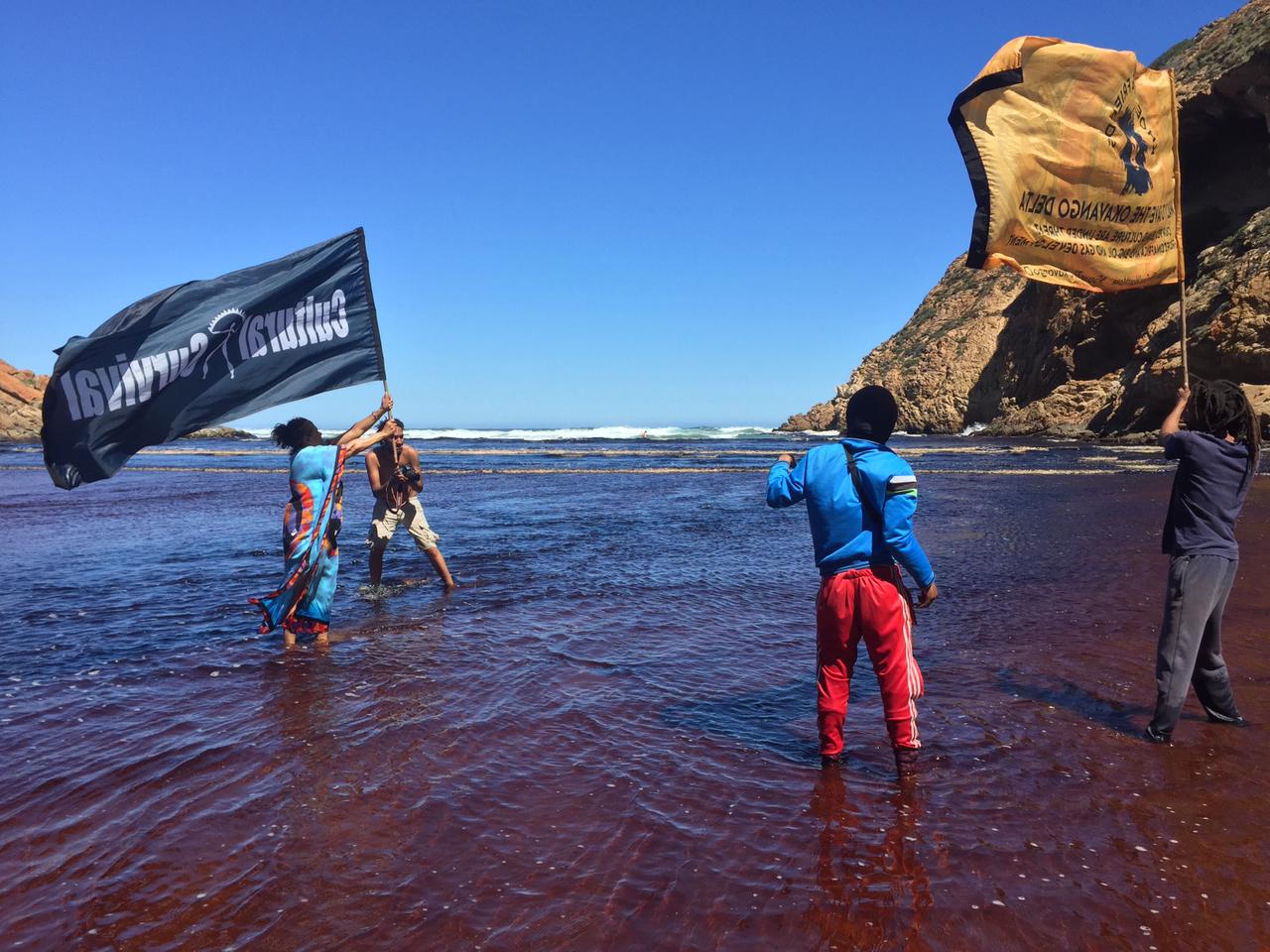
First Peoples Southern Africa’s #Indigiwalk to Save the Okavango Delta from oil and gas exploration. Photo courtesy of Khoe, San & Friends: Walk to Save the Okavango Delta.
Conservation and Violence Against Indigenous Peoples
Time and time again, Indigenous Peoples have been sidelined from environmental decision-making and violently removed from their lands in external attempts to set aside land from human activity for national parks in the U.S. and elsewhere. This has resulted in blatant violation of Indigenous rights and Indigenous genocide. According to Rights and Resources Initiative’s “Rights-Based Conservation” report, which addresses the exclusion of protections for Indigenous Peoples in the Convention on Biological Diversity’s 30x30 proposal, “It has been estimated that up to 136 million people were displaced in formally protecting half of the Earth’s currently protected area.” Former UN Special Rapporteur on the Rights of Indigenous Peoples Victoria Tauli-Corpuz highlighted the violence of “fortress conservation” in her 2018 report, “Cornered by Conservation,” which it states leads to “chronic patterns of abuse and human rights violations.”
Separating Indigenous Peoples from land is also ineffective and anti-scientific from a conservation standpoint. Indigenous Peoples know, and western scientific studies also show, that ecosystem health, biodiversity enhancement, and ecological balance result from Indigenous Peoples’ stewardship. Dr. Robin Wall Kimmerer (Citizen Potawatomi) writes, “Especially in the Americas and Australia… the ‘myth of the pristine’...supposes that the landscape encountered at the time of European settlement was in a ‘state of nature’ and free from human disturbance. In the Americas, this perspective ignores at least twelve thousand years of human history of land management and an even longer period in Australia...There is now abundant evidence that the pre-European settlement landscape was the product of Indigenous natural resource management...Therefore, it may not be possible to restore the pre-settlement landscape without also restoring the traditional land management practices.” Restoration and conservation of lands entail restoration and conservation of relationship with the Indigenous communities who are part of those lands, and the Biden-Harris administration must work to ensure that Indigenous Peoples are never again separated from their lands under the guise of conservation or for any reason.
Cultural Survival agrees with the administration’s 30x30 report that ongoing human relationships with conserved lands can be consistent with the health of natural systems, and there is no one better situated to lead this work than Indigenous Peoples, who have lived in a reciprocal, sustainable, and mutually beneficial relationship with their lands and waters since time immemorial. While Indigenous Peoples are leading conservation and restoration efforts, Indigenous Peoples should not be required to shoulder the burden of healing damage largely caused by outside economic and political forces, and these efforts should be resourced, supported, and amplified in accordance with Indigenous self-determined decision-making and consent. This moment is rich with opportunities for partnership, co-management, and federal support for work Native Nations are already doing for the benefit of all who rely on this continent’s forests, waters, mountains, deserts, and prairies.
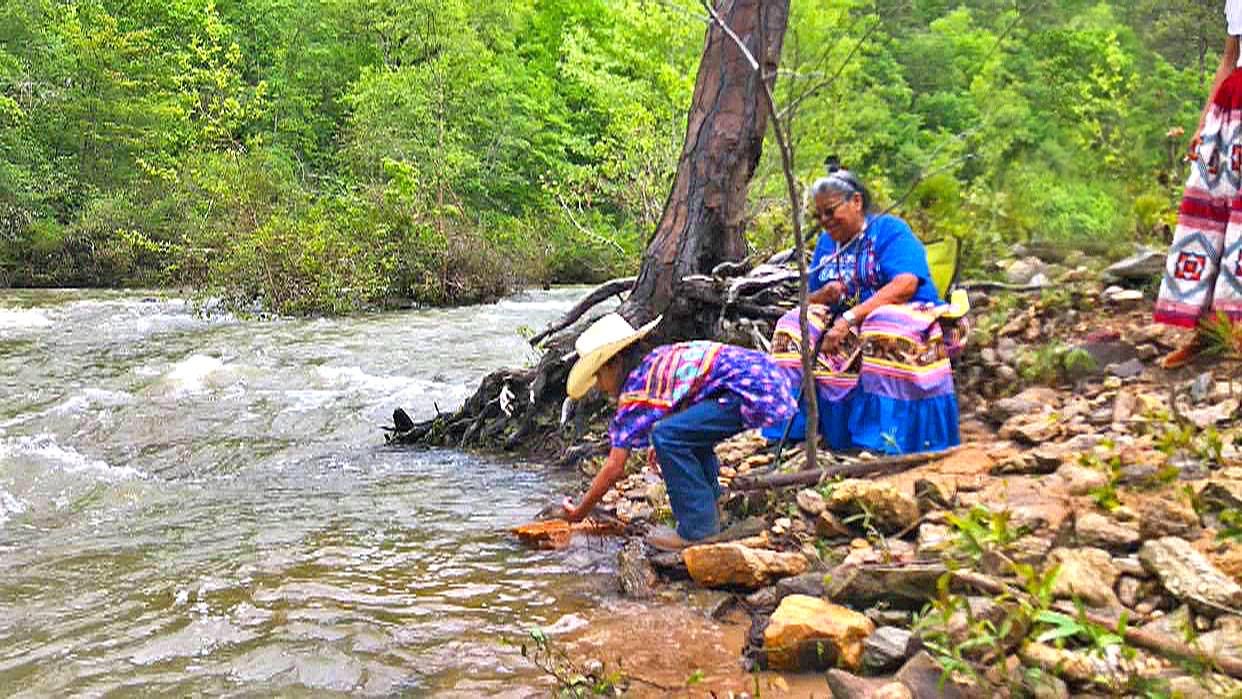
Ekvn-Yefolecv is creating an ecovillage community that provides opportunity for individuals and kin to revitalize Maskoke language, traditions, and worldview while committing to environmental sustainability. Photo courtesy of Ekvn-Yefolecv - Maskoke.
Respecting Indigenous Peoples’ Self-Determination and Right to Free, Prior and Informed Consent, as well as Treaty Obligations, is Non-Negotiable
Indigenous Peoples have the right to Free, Prior and Informed Consent regarding decisions and projects that affect their lands, territories and resources. This right is enshrined in international agreements such as the UN Declaration on the Rights of Indigenous Peoples, which the U.S. endorsed in 2010. They also have the right to federal compliance with treaty obligations. Indigenous Peoples both hold the knowledge, experience, and values to lead conservation efforts, and they also have a right to make decisions about conservation projects that might be considered on their territories. Cultural Survival urges the Biden-Harris administration to respect this right and to forge a new path where previous administrations have reneged on their treaty obligations and other domestically and internationally enshrined obligations to Indigenous Peoples. A holistic, rights-based approach to the 30x30 is fundamental, with some noted recommendations to follow. It is also essential to note that each Indigenous Nation and community will hold its own perspective on conservation approaches in general and the 30x30 initiative in particular. We respect Indigenous Peoples’ right to determine their responses to the initiative and their own approaches.
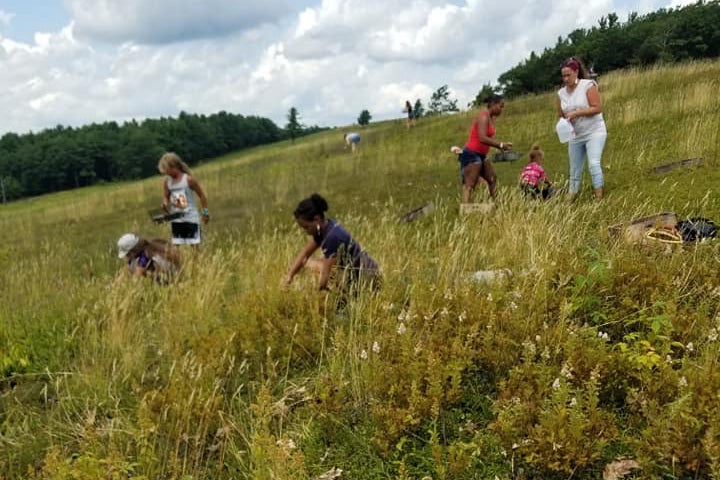
Families harvesting wild blueberries in Nipmuc homelands of Western Massachusetts, Eastern Woodlands Rematriation. Photo by Marcy Hendricks (Mashpee Wampanoag).
Indigenous Peoples’ Ecological Knowledge and Land Relationships are Critical to Achieving Conservation Goals
There is substantial evidence from both Indigenous and western scientific sources that biocultural approaches to conservation and restoration lead to deep, thorough, and lasting conservation and restoration. Recent research demonstrates that while Indigenous Peoples around the globe represent 6.2 percent of the population - 474.6 million people - they manage or hold tenure over 25 percent of the planet’s land, support about 80 percent of global biodiversity, and manage at least 24 percent of the total carbon stored in aboveground tropical forest biomass.
Cultural Survival commends the plan’s emphasis on the role of local communities, such as coastal communities, in responding to climate change and developing solutions suited to their ecosystems. Indigenous Peoples hold unparalleled Traditional Ecological Knowledge (TEK) based on their ancient and ongoing relationships with their lands and waters. This knowledge is place-based, holistic and systems-oriented, nuanced, and rooted in and reinforced by Indigenous languages and cultures, and it is developed through active relationships with land over time, passed down, developed, and adapted over generations since time immemorial. It contains a vast breadth and depth of information that may not be justly understood in its entirety through any amount of western scientific study and is inseparable from respect for the land and its inhabitants. Indigenous Peoples are demonstrated leaders in conservation with immense potential to support this campaign with climate, ecological, and relationship-based solutions.
Meanwhile, prohibiting Indigenous Peoples from carrying out traditional land management - on top of violating their inherent rights - is environmentally disastrous. The annual wildfires in the western U.S., while exacerbated by climate change, are rooted in years of poor management stemming from U.S. governmental policy of fire suppression. Indigenous Peoples in the U.S. and worldwide have intentionally and skillfully used fire, or cultural burning, to many ends, including pest control, cultivation of wild foods, and assistance with the harvest of seeds and insects; over 70 uses have been recorded. Ironically, fire suppression has led to fuel buildup and more extreme and uncontrollable fires. Now, the U.S. Forest Service, along with counterparts in other countries, is turning to Indigenous Peoples for assistance in incorporating traditional knowledge about burning into their practices. While this acknowledgement of the importance of this ancient practice is a step toward implementing it in certain contexts, it is crucial to ensure that Indigenous Peoples have access to lead cultural burning and other decision-making on their lands. Doing so will benefit all peoples. Leaf Hillman, Karuk Ceremonial Leader and Director of Natural Resources and Environmental Policy for his Tribe, said, “Humans have excluded this fire from this natural system and have created unnatural conditions. Fire is our relation and we need to work with fire.”
During the Native Peoples Action 30x30 panel, Crystal Nelson (Tlinglit) highlighted the Indigenous guardian programs in Canada as a model for collaborations centering Indigenous governance and management. Some guardian programs involve population assessments, such as using underwater microphones to detect whale songs and thus determine population presence and movement, gauging industrial noise in forests to determine ecosystem impacts, and patrolling territories for general and unauthorized human use, including overharvesting of food and medicine plants, among many other projects, some of which include collaborations with governments and other non-Indigenous institutions.
Vicky Tauli-Corpuz and her co-authors highlighted several conservation benefits to protecting Indigenous Peoples’ rights to their lands: “When bulldozers or park rangers force Indigenous Peoples from their homes, it is not only a human rights crisis—it is also a detriment to all humanity. Indigenous Peoples have long stewarded and protected the world’s forests, a crucial bulwark against climate change. The rate of tree cover loss is less than half in community and indigenous lands compared to elsewhere. Where community rights to own their lands are legally recognized, the difference is even greater. Worldwide, community lands hold at least a quarter of aboveground tropical forest carbon—equal to four times global greenhouse gas emissions for 2014—and likely much more. This research also shows that Indigenous Peoples and local communities are investing substantially in conserving their forests—up to $USD 1.71 billion in the developing world. They are achieving at least equal conservation results with a fraction of the budget of protected areas, making investment in Indigenous Peoples themselves the most efficient means of protecting forests.” A Rights and Resources Initiative report declared that there is an “urgent need to make collective tenure security a critical part of national emission reduction strategies. Empowering forest peoples to continue their historical role as stewards of the environment is not only essential for stabilizing Earth’s climate.” Similarly, a 2019 paper published in Biological Conservation argued that conservation “is increasingly likely to fail without Indigenous consent,” a point made more salient when it is taken into account that conservation of the environment includes conservation of relationships with the peoples of that environment. Indigenous Peoples’ land tenure and decision-making are fundamental to climate change mitigation and adaptation, biodiversity promotion, and even the prevention of future pandemics.
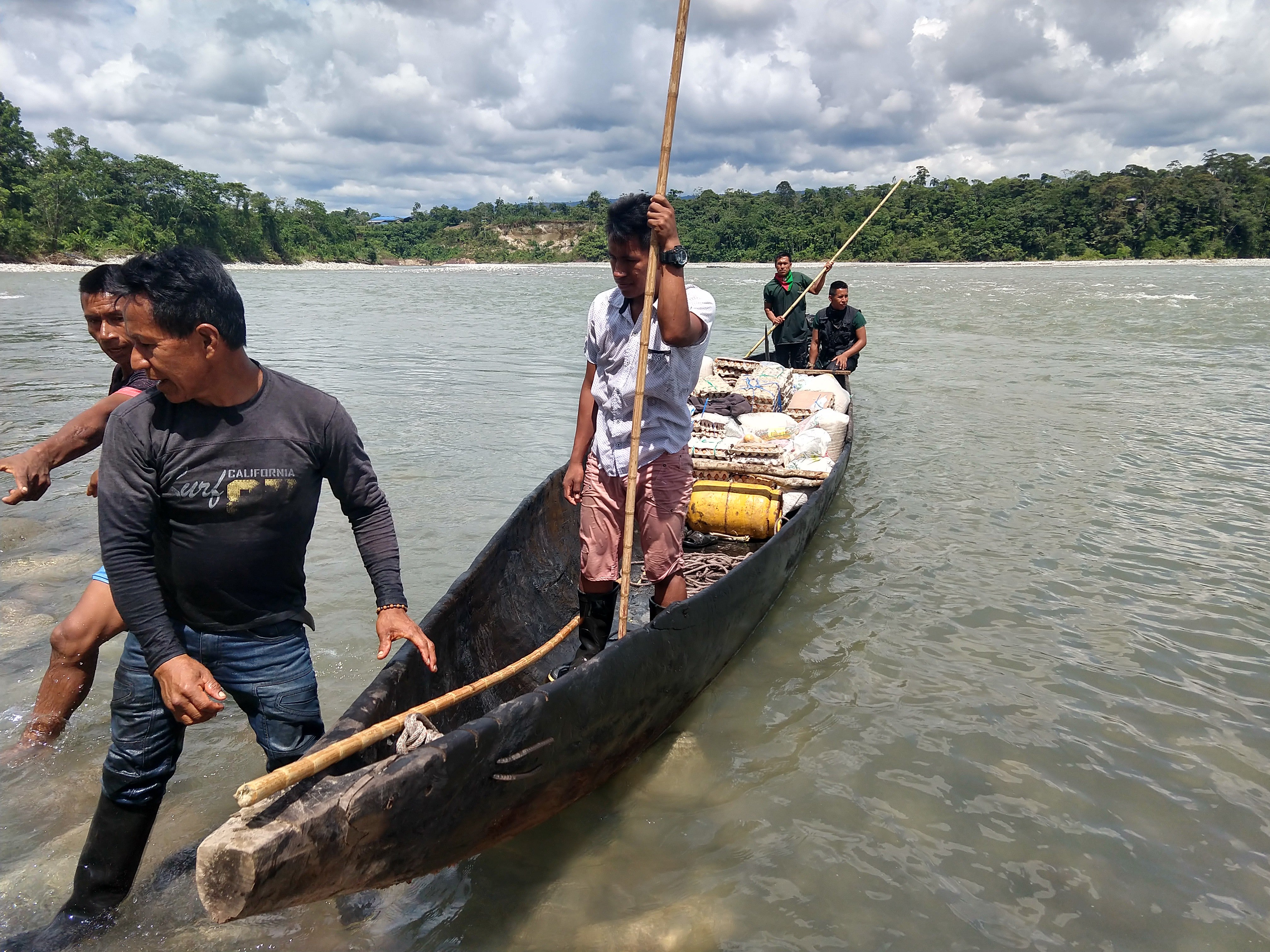
Delivering food and medicine in Ecuador during the COVID-19 pandemic. Photo courtesy of Comunidad Sinangoe - A’I Cofán.
Indigenous Peoples on the Front Lines of Climate Disasters
Meanwhile, climate change is causing devastation that disproportionately affects Indigenous Peoples, as their rights to self-determination and participation in decision-making processes are violated. Fires have torn through Native lands in California, and Indigenous migrant farmworkers have endured hazardous conditions as they worked through wildfires, remaining in zones otherwise evacuated. The Isle de Jean Charles Band of Biloxi-Chitimacha-Choctaw Tribe has lost 98 percent of their 22,400-acre island off the Louisiana coast due to sea level rise and other destruction following Hurricane Katrina and three others. Austin Ahmasuk explained on the Native Peoples’ Action panel on 30x30 that his community is losing access to the ocean as the Arctic thaws, describing “the delicate balance that exists in the Arctic. One of the reasons the Arctic is so productive, one of the reasons our land is so productive, is because of cold...and that balance is now being undermined by lots of climate change influences, some of which have resulted in the near disappearance in some of the basic food trophic levels that exist in the Arctic, the disappearance of Saffron cod, rainbow smelt, near complete collapse of the red king crab in our region...Our life absolutely revolves around the marine maritime environment.” It is broadly recognized that Indigenous Peoples globally are some of the most heavily impacted as climate change strengthens storms, increases the intensity and frequency of fires, and interrupts other ecological patterns and balance.
Indigenous Peoples’ livelihoods, economies, health, well-being, and food systems are deeply tied to their lands, territories and natural resources. Just as it is impossible to separate the condition of lands from the Indigenous Peoples who tend them, it is impossible to separate Indigenous knowledge from Indigenous Peoples. Knowledge, like other resources, can be and has been violently extracted and appropriated. International agreements such as the Convention on Biological Diversity, Article 8(j), and the UN Declaration on the Rights of Indigenous Peoples, Article 31, seek to protect Indigenous Peoples’ rights to their knowledge and how it is used. Collaborations must, above all, consult Indigenous Peoples about their participation and leadership, involved Indigenous Peoples in decision-making, respect Indigenous Peoples’ rights to determine what knowledge they share and its application in these contexts, and in particular, they should prioritize supporting and resourcing Indigenous Peoples implementing self-determined projects on their own lands.
Holistic Conservation
Indigenous Peoples understand that all of the Earth’s ecosystems are intertwined. While the goal of protecting at least 30 percent of lands and waters under U.S. stewardship is important, the initiative must also address the dangers of continued U.S. facilitation, resourcing, and backing of pipelines, oil drilling, fracking, and other extractive development projects which not only contaminate Indigenous Peoples’ lands, territories, and natural resources, but also have devastating impacts globally as they infiltrate waters, soils, air, and other interconnected systems. In many cases, the U.S. has allowed for extractive industries to operate even within established conservation lands, as was proposed in the Arctic National Wildlife Refuge and Bears Ears National Monument, both sacred lands to the respective Indigenous Peoples that call those lands home. President Biden has made positive steps early in his administration by ordering a moratorium on new oil and gas leases on federal land and water areas and by revoking the permit to the Keystone XL pipeline. Yet he has also consistently stated that he will not ban fracking, even in the face of building pressure from climate activists.
Recommendations for Collaboration
Building off Cultural Survival’s open letter to the Biden-Harris administration with 15 calls to action to honor Indigenous rights, we highlight and elaborate on the following fundamental recommendations for approaching this work. It cannot be overstated how critical it is that the 30x30 initiative is implemented and in accordance with these priorities noted below.
- Respect and honor Indigenous Peoples’ rights through the operationalization of principles within the United Nations Declaration on the Rights of Indigenous Peoples (UNDRIP) into domestic U.S. law.
- Respect for and the prioritization of Indigenous Peoples’ self-determination and their right to Free, Prior and Informed Consent are non-negotiable.
- Honor and carry out all existing treaty obligations, and respect Indigenous Peoples and Native Nations as the best experts and stewards of their lands, territories, and natural resources. More broadly, this also includes honoring Indigenous Peoples’ land rights and customary land tenure and incorporating this into conservation strategies and practices related to biodiversity protection, climate change, and a just transition.
- Ensure federally recognized Tribal lands and allotments are safeguarded, including those pending and applying for such recognition, and uplift and protect Tribal sovereignty, especially as the U.S. continues to experience and address climate change. This includes supporting and resourcing Indigenous Peoples’ and Native Nations’ ability to maintain Tribal lands and their self-determined development on their lands.
- Facilitate the return of land and its legal, protected title to Indigenous Peoples, communities, and Tribes, and continue to do this through the U.S. Department of Interior by returning land from state and national parks.
- Indigenous Peoples’ Traditional Ecological Knowledge (TEK) and their land relationships are critical to achieving conservation goals; therefore, their leadership must be centered in all layers of decision-making.
- In addition to centering and prioritizing Indigenous Peoples’ leadership, local, county, state, and federal governments must financially resource, back, and support Indigenous Peoples’, communities, Tribes, and their leadership as outlined in UNDRIP Article 39: “Indigenous Peoples have the right to have access to financial and technical assistance from States and through international cooperation, for the enjoyment of the rights contained in this Declaration.”
- Enhance funding for Indigenous Peoples and Native Nations’ engagement, capacity building, and technical assistance – they are technical experts in forest health, climate action, and biodiversity resiliency, and funding is required to fully support their engagement and contributions in this critically important leadership role. This means resourcing their self-determined capacity building and trainings to empower Indigenous Peoples and Native Nations’ full participation and representation in conservation and restoration.
- Local, state, and the U.S. federal governments must work in collaboration with Indigenous Peoples to achieve conservation goals, and this includes earmarking public funding specifically to both support Indigenous Peoples and Native Nations’ self-determined conservation efforts, as well as financially resource their full participation and representation in nation-to-nation dialogue and decision making processes. Indigenous Peoples and Native Nations should also be consulted in annual budgetary planning and resource allocation processes in collaboration with local, state, and federal governments on public funding.
- Local, state, and federal governments shall recognize, review, and publicly address their contributions to land theft, genocide, and violations of Indigenous Peoples’ rights, and work towards collective reconciliation to support healing as a measure to enable bi-partisanship between the U.S and Indigenous Peoples.
- In partnerships with Indigenous Peoples to carry out the 30x30 initiative, ensure the engagement of all Indigenous Peoples within the lands and territories of the United States, regardless of federal recognition, understanding that their relationship with the land exists whether this is legally recognized by the U.S. federal government or not; whether they are citizens of the U.S. or not (including border Tribal communities whose homelands span across the U.S and surrounding countries), and whether they have been removed from their original homelands or not.
- In order to be successful in its goals, the administration must understand the 30x30 initiative as one element within a broader strategy towards a transition to a just, green economy. Additional elements must strengthen Indigenous Peoples’ leadership and participation in this new economy, by ensuring and prioritizing equitable access to health care, higher education, broadband, and workforce opportunities.
The 30x30 initiative has the potential to serve as a powerful step in the journey to repair our relationship with Mother Earth, by ensuring Indigenous Peoples’ rights, sovereignty, and Free, Prior and Informed Consent is fundamental. Indigenous communities across the continent have demonstrated their commitment to environmental conservation and Tribal leaders have generously offered their guidance and leadership, yet will require their leaderships to both be respected and included, but also financially resourced. Cultural Survival urges the Biden-Harris administration to support Indigenous-led programs that transmit and revitalize cultural knowledge in communities and that put land back in Indigenous hands, and we encourage the administration to do everything in its power to use the 30x30 platform as a means to facilitate Indigenous Peoples’ ability and access to continuing to engage in the work and relationships they have carried out on this land since time immemorial.
